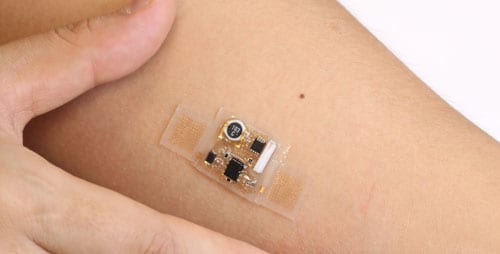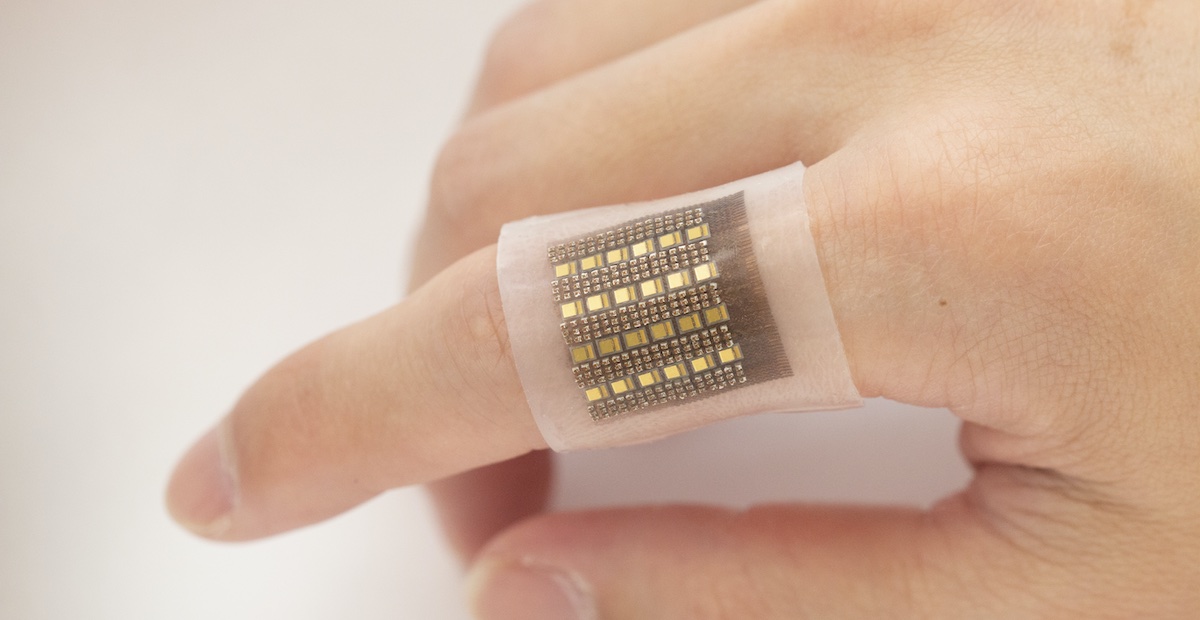
Wearing a fitness tracker on your wrist or clipped to your belt is so 2013.
Engineers at the University of Illinois at Urbana-Champaign and Northwestern University have demonstrated thin, soft stick-on patches that stretch and move with the skin and incorporate commercial, off-the-shelf chip-based electronics for sophisticated wireless health monitoring.
The patches stick to the skin like a temporary tattoo and incorporate a unique microfluidic construction with wires folded like origami to allow the patch to bend and flex without being constrained by the rigid electronics components. The patches could be used for everyday health tracking – wirelessly sending updates to your cellphone or computer – and could revolutionize clinical monitoring such as EKG and EEG testing – no bulky wires, pads or tape needed.
“We designed this device to monitor human health 24/7, but without interfering with a person’s daily activity,” said Yonggang Huang, the Northwestern University professor who co-led the work with Illinois professor John A. Rogers. “It is as soft as human skin and can move with your body, but at the same time it has many different monitoring functions. What is very important about this device is it is wirelessly powered and can send high-quality data about the human body to a computer, in real time.”
The researchers did a side-by-side comparison with traditional EKG and EEG monitors and found the wireless patch performed equally to conventional sensors, while being significantly more comfortable for patients. Such a distinction is crucial for long-term monitoring, situations such as stress tests or sleep studies when the outcome depends on the patient’s ability to move and behave naturally, or for patients with fragile skin such as premature newborns.
The team will publish its design in the April 4 issue of Science. See video.
Rogers’ group at Illinois previously demonstrated skin electronics made of very tiny, ultrathin, specially designed and printed components. While those also offer high-performance monitoring, the ability to incorporate readily available chip-based components provides many important, complementary capabilities in engineering design, at very low cost.
“Our original epidermal devices exploited specialized device geometries – super thin, structured in certain ways,” Rogers said. “But chip-scale devices, batteries, capacitors and other components must be re-formulated for these platforms. There’s a lot of value in complementing this specialized strategy with our new concepts in microfluidics and origami interconnects to enable compatibility with commercial off-the-shelf parts for accelerated development, reduced costs and expanded options in device types.”
The multi-university team turned to soft microfluidic designs to address the challenge of integrating relatively big, bulky chips with the soft, elastic base of the patch. The patch is constructed of a thin elastic envelope filled with fluid. The chip components are suspended on tiny raised support points, bonding them to the underlying patch but allowing the patch to stretch and move.
One of the biggest engineering feats of the patch is the design of the tiny, squiggly wires connecting the electronics components – radios, power inductors, sensors and more. The serpentine-shaped wires are folded like origami, so that no matter which way the patch bends, twists or stretches, the wires can unfold in any direction to accommodate the motion. Since the wires stretch, the chips don’t have to.
A downloadable image and video gallery is available (password: microfluidics).
Skin-mounted devices could give those interested in fitness tracking a more complete and accurate picture of their activity level.
“When you measure motion on a wristwatch type device, your body is not very accurately or reliably coupled to the device,” said Rogers, a Swanlund Professor of Materials Science and Engineering at the U. of I. “Relative motion causes a lot of background noise. If you have these skin-mounted devices and an ability to locate them on multiple parts of the body, you can get a much deeper and richer set of information than would be possible with devices that are not well coupled with the skin. And that’s just the beginning of the rich range of accurate measurements relevant to physiological health that are possible when you are softly and intimately integrated onto the skin.”
The researchers hope that their sophisticated, integrated sensing systems could not only monitor health but also could help identify problems before the patient may be aware. For example, according to Rogers, data analysis could detect motions associated with Parkinson’s disease at its onset.
“The application of stretchable electronics to medicine has a lot of potential,” Huang said. “If we can continuously monitor our health with a comfortable, small device that attaches to our skin, it could be possible to catch health conditions before experiencing pain, discomfort and illness.”
The Latest on: Electronic patches for health monitoring
[google_news title=”” keyword=”Electronic patches for health monitoring” num_posts=”10″ blurb_length=”0″ show_thumb=”left”]
via Google News
The Latest on: Electronic patches for health monitoring
- Vivalink launches turnkey cardiac monitoring techon May 8, 2024 at 12:33 pm
Vivalink announced today that it launched its technology solution designed to enhance mobile cardiac telemetry (MCT) and Holter monitoring.
- May 2024 Android security patch here for Pixel phones and the Pixel Tableton May 7, 2024 at 11:34 am
Android security patch is rolling out now to Google Pixel devices. Do a software update check in System Settings!
- Apex Legends Update 2.56 Patch Notes For Season 21 Revealedon May 6, 2024 at 12:13 pm
Season 21 of Apex Legends, also known as 'Upheaval', is set to launch for PlayStation 4, PlayStation 5, Xbox One, Xbox Series X|S, Nintendo Switch, and PC tomorrow, and we've finally received the full ...
- The Electronic Wireless Show podcast: a patch of patcheson May 2, 2024 at 8:01 am
On this week's episode of our fine PC gaming podcast we chat about all the patches that are coming out, and how that might have changed our attitudes to games.
- Patch could cure back painon April 29, 2024 at 5:00 pm
A 'pain' patch developed for patients with cancer could help thousands of people beat the agony of chronic back problems. Research shows that the prescriptiononly-Durogesic patch results in a ...
- A Novel Patch for Heart Rhythm Monitoringon April 29, 2024 at 5:00 pm
From a technological standpoint, the miniaturization of the Holter monitor concept ... adopting the Zio Patch as a loss-leader, absorbing the expense. SuddenLife: A Consumer Health Alternative ...
- Top 8 Best Nicotine Patches in 2024on April 20, 2024 at 5:00 pm
People who are trying to quit smoking frequently use nicotine patches as a commonly sought-after help because they assist in alleviating withdrawal symptoms. Nicotine is delivered into the ...
- Melatonin Sleep Patches Helped Me Get My Sleep Back on Track. Here's Howon April 16, 2024 at 11:00 am
I tested Fleur Marche's Sleep Plz patches to see if melatonin sleep patches work. Here's how I slept. Taylor Leamey writes about all things wellness, specializing in mental health, sleep and ...
- Can Sleep Patches Improve Your Mental Health?on April 13, 2024 at 5:00 pm
Now, you can patch up for everything from calm to energy to sleep. Sleep and mental health are bedfellows, so to speak, because when you have sleep probs, you’re at a higher risk of developing a ...
- The latest in 'patch' technologyon April 12, 2024 at 5:00 pm
Developed in the U.S. by Advanced Health And Beauty, the patch recently became available here. 'ALTERNATIVE' PATCH Patches that address the growing demand for natural remedies are also being ...
via Bing News









